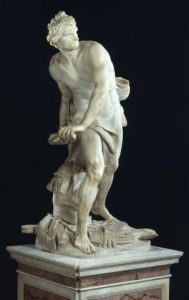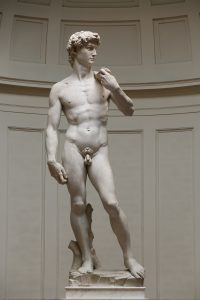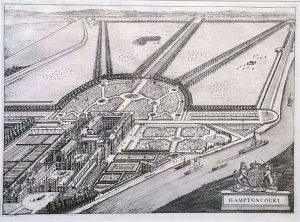1. Introduction and Historical Context
This brief introduction to the Baroque period is intended to provide a short summary of the music and context in the Baroque Era, which lasted from about 1600-1750. This period includes several composers that we now hear on so-called “classical” music stations. You are probably familiar with such names as Bach, Handel, and Pachelbel (whose Canon is used in many modern weddings). You have almost certainly heard snippets of these composers on TV shows, commercials, or movies. In this section, we will add some context and history to these and many other personalities from the Baroque Era.
It’s appropriate that we hear Handel and his contemporaries in commercials today considering the Baroque era was essentially the first age in which music became a commercial commodity. Opera in the 17th century was the entertainment equivalent of movies today. The biggest opera stars in 1720 were followed around by paparazzi and gossiped about just as are, say, Brad Pitt and Angelina Jolie. You’ll encounter more on that when you get to the opera portion of this chapter.
The term “baroque” has an interesting and disputed past. It ultimately is thought to have derived from the Italian word barocco. Philosophers during the Middle Ages used this term to describe an obstacle or veering from schematic logic. Later the term came to denote or bring attention to any contorted idea, obscure thought, or anything different, out of the ordinary, or strange. Another possible origin is from the Portuguese term barroco, in Spanish barrueco. Jewelers use this term even today to describe irregular or imperfectly shaped pearls: a baroque pearl. The baroque period is a time of extremes resulting from events stemming back to the Renaissance. The conflict between the reformation and counter-reformation, and the influence of Greek/Roman culture as opposed to medieval roots are present throughout the Baroque era.
In art circles, the term “baroque” came to be used to describe the bizarre, irregular, grotesque, or anything that departs from the regular or expected. This definition was adhered to until 1888 when Heinrich Wölfflin coined the word as a stylistic title or designation. The baroque title was then used to describe the style of the era. The term “rococo” is sometimes used to describe art from the end of the Baroque period, from the mid to late 18th century. The Rococo took the extremes of baroque architecture and design to new heights with ornate design work and gold gilding. Historical events and advances in science influenced music and the other arts tremendously. It is not possible to isolate the trends of music during this period without briefly looking into what was happening at the time in society.
1.1 Science
Sir Isaac Newton (1643-1727) and his studies made a great impact on Enlightenment ideology. In addition to creating calculus, a discipline of mathematics still practiced today, he studied and published works on universal gravity and the three laws of motion. His studies supported heliocentrism, the model of the solar system’s planets and their orbits with the sun. Heliocentrism invalidated several religious and traditional beliefs.
Johannes Kepler (1571–1630), a German astronomer, similarly re-evaluated the Copernican theory that the planets move in a circular motion in their orbits around the sun. In utilizing Tycho Brahe’s records, Kepler concluded that the planets move in ellipses in their orbits around the sun. He was the first to propose elliptical orbits in the solar system.
William Harvey (1578-1657) conducted extensive anatomical research concerning the circulatory system. He studied the veins and arteries of the human arm and also concluded that the blood vessel system is an overall circle returning back to the heart while passing through the lungs.
1.2 Philosophy
René Descartes (1595–1650) was a famous philosopher, mathematician, and scientist from France. He is arguably considered to be one of the pioneer modern philosophers to make an effort to defeat skepticism. His opinions on the relationship of the body and mind as well as certainty and knowledge have been very influential. He laid the foundation for an analysis and classification of human emotions at a time when more and more writers were noting the powers of music to evoke emotional responses in their listeners.
John Locke (1632–1704) is regarded as the founder of the Enlightenment movement in philosophy. Locke is believed to have originated the school of thought known as British Empiricism, laid the philosophical foundation for the modern idea of limited liberal government. Locke believed that each person has “natural rights,” that government has obligations to its citizens, that government has very limited rights over its citizens and, in certain circumstances, it can be overthrown by its citizens.
1.3 Art
Gian Lorenzo Bernini (1598–1680) was a famous Italian sculptor of the Baroque era. He is credited with establishing the Baroque sculpture style. He was also a well-known architect and worked most of his career in Rome. Although he enjoyed the patronage of the cardinals and popes, he challenged artistic traditions. His art reflects a certain sense of drama, action, and sometimes playfulness. Compare for instance his sculpture of David (1623-1624) with the David sculpture (1501-1504) of Renaissance artist Michelangelo. While Michelangelo’s David appears calmly lost in contemplation, Bernini’s David is in the act of flinging his slingshot, jaw set and muscles tensed. We see similar psychological intensity and drama in music of the Baroque period.


Elaborate formal Baroque gardens indicating man’s control over nature were used to demonstrate the owner’s power and prestige. France was a major contributor to the development of these highly ornamental gardens. These gardens became associated with autocratic government. The designs of these elaborate gardens were from “Cartesian” geometry (science and mathematics) while drawing the landscape into the composition. Look at the Leonard Knyff’s drawing of the Hampton Court Baroque garden.

1.4 Literature
Literature during the Baroque period often took a dramatic turn. William Shakespeare (1564–1616), playwright and poet, wrote the play Hamlet and many other great classics still enjoyed by millions of readers and audiences today. Music composers have long used Shakespeare’s writing for text in their compositions; for example, his Hamlet was used as the basis for an opera. Shakespeare’s writings depict an enormous range of human life, including jealousy, love, hate, drama, humor, peace, intrigue, war, as well as all social classes—matters that provide great cultural entertainment.
Jean Racine (1639–1699) wrote tragedies in the neo-classical (anti-Baroque) and Jansenism literary movements. Many works of the classical era utilized rather twisted complicated plots with simple psychology. Racine’s neo-classical writing did just the opposite, incorporating simple and easy to understand plots with challenging uses of psychology. Racine is often grouped with Corneille, known for developing the classic tragedy form. Racine’s dramas portray his characters as human with internal trials and conflicting emotions. His notable works include Andromaque, Phèdre, and Athalie.
Miguel de Cervantes (1547–1616) was a Spanish playwright, poet, and novelists. Don Quixote is his most famous work and is often considered the first modern novel from Europe. It was published in 1605 and portrays the traditions of Sevilla, Spain. Legend has it that the early portions of Don Quixote were written while the author was in jail for stealing.
Other Baroque-era authors include John Milton (1608–1674), author of the epic Paradise Lost; John Dryden (1631–1700), dramatist and poet who wrote several semi-operatic works incorporating music by contemporary composer Henry Purcell; Jonathan Swift (1667–1745) an Anglo-Irish essayist and proto-novelist, poet, and cleric who authored Gulliver’s Travels; and Henry Fielding (b. 1707–1754) a proto-novelist and dramatist who authored Tom Jones.
We will find a similar emphasis on drama as we study Baroque music, especially in the emergence of genres such as opera and oratorio.
1.5 Politics
In politics, three changes that started in the Renaissance became defining forces in the Baroque period. First, nation-states (like France and England) developed into major world powers, ruled by absolutist monarchs. These absolute monarchs were kings and queens whose authority, it was believed, was divinely bestowed upon them. They amassed great power and wealth, which they often displayed through their patronage of music and the other arts. With the rise of this system of absolutism, the state increasingly challenged the power base of the Church. In the case of Germany, these nation-states were smaller and often unstable. Second, Protestantism spread throughout northern Europe. Places such as England, where George Frideric Handel spent most of his adult life, and central Germany, where Johann Sebastian Bach spent all of his life, were Protestant strongholds. J. S. Bach wrote a great deal of music for the Lutheran Church. Third, the middle class continued to grow in social and economic power with the emergence of printing and textile industries and open trade routes with the New World (largely propelled by the thriving slave trade of the time).
1.6 Exploration and Colonialism
The 1600s saw the first era of the Colonization of America. France and England were the most active in the colonization of America. The quest for power in Europe, wealth/economics and religious reasons energized the colonial progression. Englishman Henry Hudson explores the later-named Hudson River in 1609; the landing of Pilgrims at Plymouth took place in 1620; Manhattan (of New York City) was bought from Native Americans in 1626; Boston was founded in 1630; and Harvard University was founded in 1636.
1.7 Musical Timeline
| Events in History | Events in Music |
| 1597: Giovanni Gabrieli writes his Sacrae Symphoniae.
1607: Monteverdi performs Orfeo in Mantua, Italy. |
|
| 1618–1648: Thirty Years War
1623: Galileo Galileo publishes The Assayer. 1642–1651: English Civil War 1643–1715: Reign of Louis XIV in France 1649: Descartes publishes Passions of the Soul. |
|
| 1687: Isaac Newton publishes his Principia. | 1678: Vivaldi born in Venice, Italy
1685: Handel and Bach born in Germany |
| 1740–1846: Reign of Frederick the Great of Prussia
|
1741: Handel’s Messiah performed in Dublin, Ireland 1750: J. S. Bach dies. |
A staged musical drama for voices and orchestra. Operas are fully blocked and performed in costume with sets. Operas utilize arias and recitatives with no narration.
A major work with religious or contemplative characters for solo voices, chorus, and orchestra. Oratorios do not utilize blocking, costumes, or scenery.
